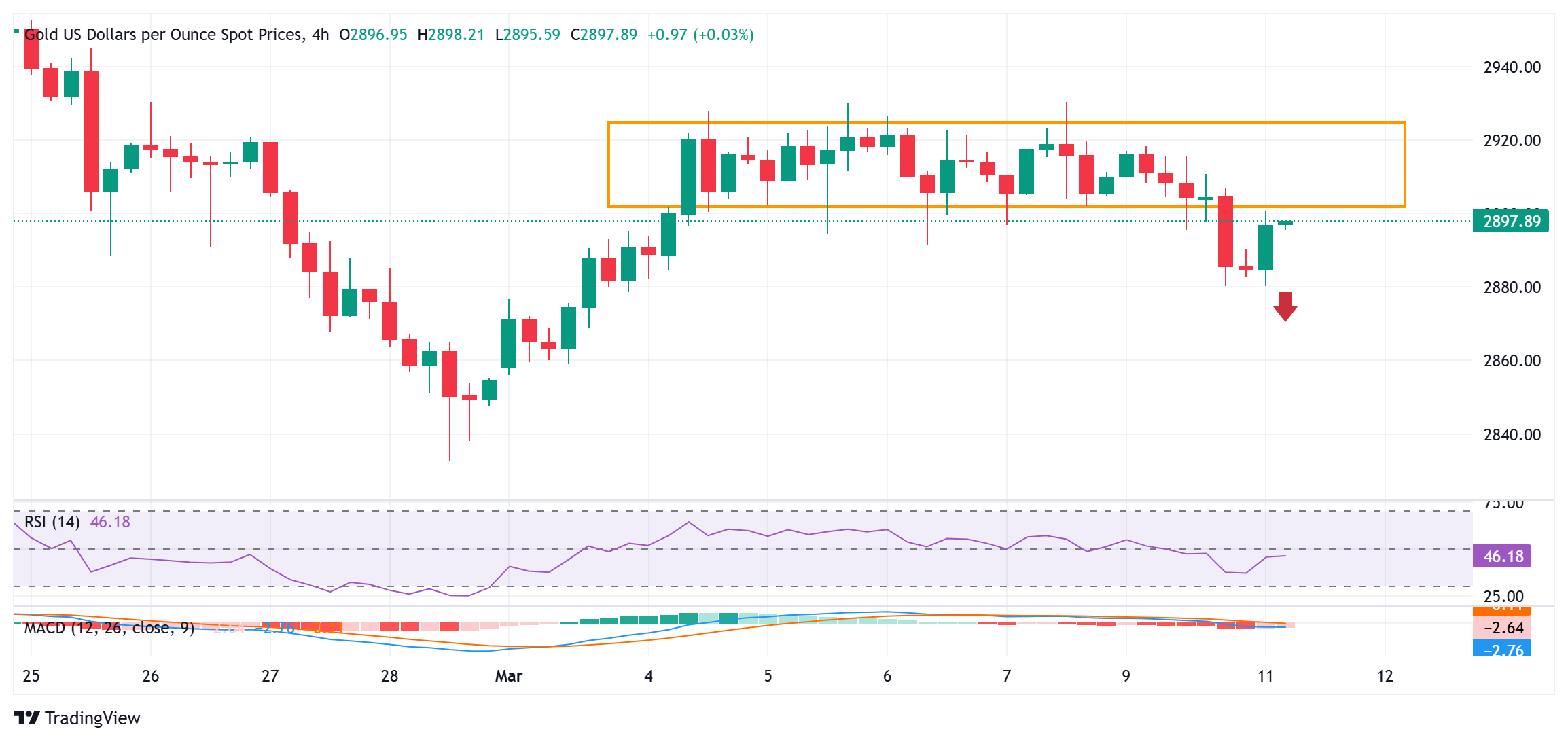Gold prices rebounded from a one-week low and were supported by a variety of factors.
Global trade war concerns and geopolitical risks continue to support the safe-haven commodity.
Fed rate cut bets weighed on the US dollar, further benefiting the non-yielding gold/USD pair.
Gold prices (XAU/USD) attracted some bargain-hunting buyers around $2,880 in Asian trading on Tuesday and reversed some of the losses from the previous day's drop to a one-week low. Uncertainty over US President Donald Trump's trade policies and their impact on the global economy continued to weigh on investor sentiment. This was evident in the general risk-averse sentiment, which, along with geopolitical risks, drove flows to safe-haven gold.
Meanwhile, expectations that a tariff-driven slowdown in the US economy could force the Federal Reserve (Fed) to cut interest rates multiple times this year have weighed on the US dollar (USD) near its lowest level since November last year. This in turn is seen as another factor supporting non-yielding gold prices. However, range-bound price action over the past week or so has bulls cautious ahead of this week's U.S. inflation data.
Investors continued to seek shelter in traditional safe-haven assets amid concerns about U.S. President Donald Trump's trade tariffs, helping gold prices rebound from a one-week low hit on Monday. In fact, Trump's 25% tariff on global steel and aluminum imports will take effect on Wednesday. In addition, the Trump administration is preparing for additional tariffs scheduled to be implemented on April 2.
Market concerns that Trump's protectionist policies could lead to a U.S. recession remain. This, coupled with signs of weakness in the U.S. labor market, further fueled market speculation that the Federal Reserve will resume its rate-cutting cycle in June. This has put pressure on U.S. Treasury yields and the dollar near multi-month lows, further supporting non-yielding gold.
Ukrainian President Volodymyr Zelensky’s meeting with Trump at the White House on February 28 ended in disaster, leading the United States to suspend all military aid to Ukraine. As a result, investors are nervous about the meeting between US officials and Ukrainian officials that begins today, which may play a key role in influencing the price action of the gold/dollar currency pair.
Later in the North American session, traders will focus on the release of the US Job Openings and Labor Turnover Survey (JOLTS). However, the focus will remain on US inflation data - the Consumer Price Index (CPI) on Wednesday and the Producer Price Index (PPI) on Thursday. This will boost the US dollar and determine the short-term direction of the precious metal.

From a technical perspective, the overnight break below the $2,900 round mark, or the lower limit of the short-term trading range, may be seen as a key trigger for short traders. Nevertheless, mixed oscillators on the daily chart make it prudent to wait for further selling pressure below the $2,880 area, which is the one-week low. The subsequent decline may drag gold prices to the intermediate support level of $2,860, and then approach the swing low of late February, around the $2,833-2,832 area, and the $2,800 mark.
On the other hand, if gold prices break further above the $2,900 mark, they may face some resistance in the $2,922-2,924 area. If they continue to break through this resistance level with strength, gold prices may break through the $2,934 resistance and retest the record high reached on February 24, around the $2,956 area.
Gold has played a key role in human history as it is widely used as a store of value and a medium of exchange. Currently, in addition to its lustre and use in jewelry, gold is widely regarded as a safe haven asset, meaning it is considered a good investment in turbulent times. Gold is also widely seen as a hedge against inflation and currency devaluation as it is not dependent on any particular issuer or government.
Central banks are the largest holders of gold. To support their currencies during turbulent times, central banks tend to diversify their reserves and buy gold to improve perceptions of economic and monetary strength. High gold reserves can be a source of confidence in a country's solvency. According to the World Gold Council, central banks added 1,136 tons of gold reserves in 2022, worth about $70 billion. This is the highest annual purchase on record. Central banks in emerging economies such as China, India and Turkey are rapidly increasing their gold reserves.
Gold is negatively correlated with the U.S. dollar and U.S. Treasuries, both of which are major reserve assets and safe havens. Gold tends to rise when the dollar depreciates, allowing investors and central banks to diversify their assets during turbulent times. Gold is also negatively correlated with risky assets. Stock market rebounds tend to push gold prices lower, while sell-offs in riskier markets tend to benefit gold.
Prices can move due to a variety of factors. Geopolitical instability or fears of a deep recession could quickly push gold prices higher due to its safe-haven status. As a low-yielding asset, gold tends to rise as interest rates fall, while higher funding costs usually weigh on gold. Still, since the asset is priced in U.S. dollars (XAU/USD), most moves depend on the performance of the U.S. dollar (USD). A strong dollar tends to control gold prices, while a weak dollar can push gold prices higher.